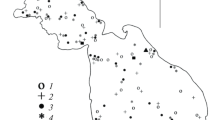Abstract
Vertical distribution of average annual temperature of water in lakes in the period of maximum water heating is analyzed as a function of zonal climatic factors and lake morphometry. Regression analysis is applied to hydrometeorological data on water temperature measurements at standard horizons made from 1958 to 1989 in 58 lakes in northwester Russia and eight lakes in Finland. The temperature of the top five-meter layer is found to depend mainly on the latitude. The major factors at a depth of 10 and lower are the lake morphometry and river water inflow.
Similar content being viewed by others
REFERENCES
Adamenko, V.N., Klimat i ozera (Climate and Lakes), Leningrad: Gidrometeoizdat, 1985.
Bol'shie ozera Kol'skogo poluostrova (Large Lakes of Kola Peninsula), Leningrad: Nauka, 1975.
Boyarinov, P.M., Efremova, T.V., Pal'shin, N.I., et al., Thermal Processes and Dynamics of the Lake, Onezhskoe ozero. Ekologicheskie problemy (Onega: Environmental Problems), Petrozavodsk: Izd. KarNTs RAN, 1999, pp. 22–48.
Gidrologiya ozer Vozhe i Lacha (Hydrology of Lakes Vozhe and Lacha), Leningrad: Nauka, 1979.
Naumenko, M.A., Guzivatyi, V.V., and Karetnikov, S.G., Daily Averaged Spatial Distributions of Temperature on the Water Surface of Lake Ladoga from May to November, Ladozhskoe ozero (Lake Ladoga), Petrozavodsk, Izd-vo KarNTs RAN, pp. 335–345.
Pal'shin, N.I., Termicheskie i gidrodinamicheskie protsessy v ozerakh v period ledostava. Petrozavodsk (Thermal and Hydrodynamic Processes in Lakes under Ice), Izd-vo KarNTs RAN, 1999.
Ryanzhin, S.V., Zonal Regularities in Elements of the Thermal Regime of Freshwater Lakes in the Northern Hemisphere, Vodn. Resur., 1991, no. 4, pp. 15–29.
Smirnova, N.P., Classification of Lakes Based on Water Temerature and Thermal Balance Elements, Teoreticheskie voprosy klassifikatsii ozer (Theoretical Problems in Lake Classification), St. Petersburg: Nauka, 1993, pp. 35–51.
Sorokin, I.N., Morphological, Morphometric, and Hydrological Characteristics and Their Role in Complex Claddification of Lakes and Their Zoning, Teoreticheskie voprosy klassifikatsii ozer (Theoretical Problems in Lake Classification), St. Petersburg: Nauka, pp. 24–35.
Strashkraba, M. and Gnauk, A., Presnovodnye ekosistemy. Matematicheskoe modelirovanie (Freshwater Ecosystems. Mathematical Modeling), Moscow: Mir, 1989.
Tikhomirov, A.I., Termika krupnykh ozer (Thermal Processes in Large Lakes), Leningrad: Nauka, 1982.
Hatchinson, D., Limnology, Moscow: Progress, 1969.
Khenderson-Sellers, B., Inzhenernaya limnologiya (Engineering Limnology), Leningrad: Gidrometeoizdat, 1987.
Khomskis, V., Dinamika i termika malykh ozer (Dynamic and Thermal Processes in Small Lakes), Vilnius: Mintis, 1969.
Ekosistema ozera Pleshcheevo (Lake Pleshcheevo Ecosystem), Leningrad: Nauka, 1989.
Arai, T., Climatic and Geomorphological Influences on Lake Temperature, Int. Ver. Theor. Angew. Limnol. Verh., 1981, vol. 21, pp. 130–134.
Carmack, E.C. and Farmer, D.M., Cooling Processes in Deep, Temperate Lakes. A Review with Examples From Two Lakes in British Columbia, J. Mar. Res., 1982, vol. 40, Suppl., pp. 85–111.
Gorham, E. and Boyce, F.M., Influence of Lake Surface Area and Depth upon Thermal Stratification and the Depth of the Summer Thermocline, J. Gr. Lakes Res., 1989, vol. 15, no. 2, pp. 233–245.
Hutchinson, G.E. and Loffler, H., The Thermal Classifi-cation of Lakes, Proc. Nat. Acad. Sci., 1956, vol. 42, no. 2, pp. 84–86.
Kuusisto, E., Suomenvesistojen Lampotilat Kaudella, 1961's1975, Vesihallitus'sNational Board of Waters, Finland. Helsinki, 1981.
Patalas, K., Mid-Summer Mixing Depths of Lakes of Different Latitudes, Int. Ver. Theor. Angew. Limnol. Verh., 1984, vol. 22, pp. 97–102.
Spigel, R.H. and Imberger, J., The Classification of Mixed-Layer Dynamic in Lake of Small to Medium Size, J. Phys. Oceanogr., 1980, vol. 10, no. 7, pp. 1104–1121.
Strashkraba, M., The Effects of Physical Variables on Freshwater Production: Analyses Based on Models, Functioning of Freshwater Ecosystems, Cambridge: Univ. Press, 1980, pp. 13–84.
Author information
Authors and Affiliations
Rights and permissions
About this article
Cite this article
Efremova, T.V., Pal'shin, N.I. Formation of Vertical Thermal Structure in Lakes in Northwestern Russia and Finland. Water Resources 30, 640–649 (2003). https://doi.org/10.1023/B:WARE.0000007590.04765.21
Issue Date:
DOI: https://doi.org/10.1023/B:WARE.0000007590.04765.21




